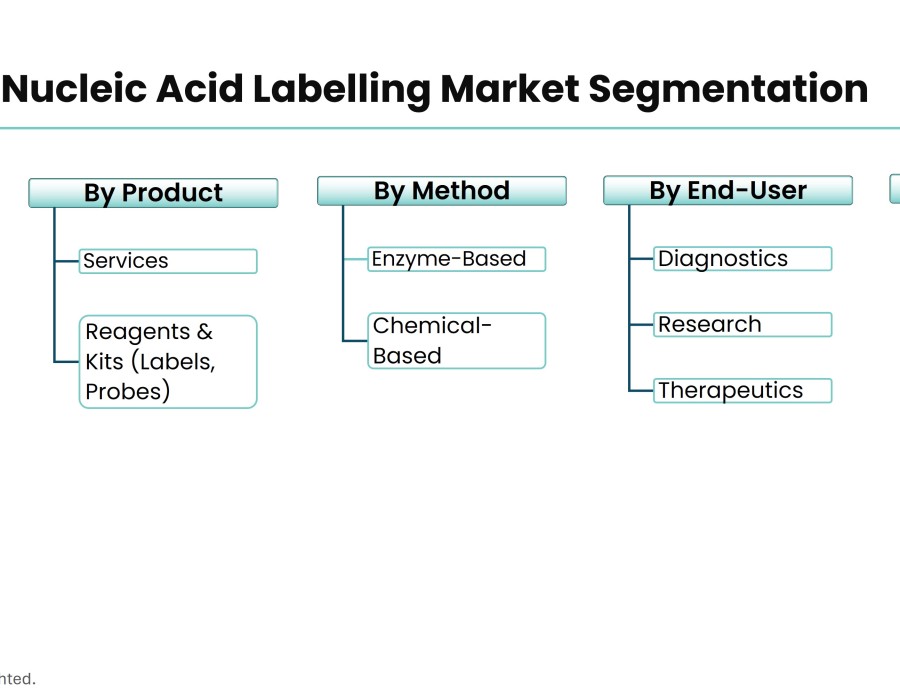The nucleic acid labeling market is experiencing rapid growth and transformation, driven by advancements in biotechnology, increased demand for personalized medicine, and the expanding application of nucleic acid-based technologies. Nucleic acid labeling, a critical process in molecular biology and diagnostics, involves attaching markers to DNA or RNA molecules to facilitate detection, tracking, and analysis. Here, we explore some of the emerging trends shaping the future of this dynamic market.
According to Stratview Research, the nucleic acid labelling market was estimated at USD 2.15 billion in 2022 and is likely to grow at a CAGR of 8.47% during 2023-2028 to reach USD 3.49 billion in 2028.
1. Rise of Next-Generation Sequencing (NGS)
Next-generation sequencing (NGS) technologies have revolutionized genomic research and diagnostics. The precision and efficiency of NGS require advanced nucleic acid labeling techniques to prepare samples for sequencing. As NGS becomes more accessible and cost-effective, the demand for innovative labeling methods that enhance accuracy and throughput is increasing. This trend is driving the development of novel labeling reagents and protocols tailored specifically for NGS applications.
2. Integration with CRISPR Technologies
CRISPR-Cas9 and other gene-editing technologies have opened new avenues for genetic research and therapeutic development. Nucleic acid labeling plays a crucial role in these technologies by enabling the identification and tracking of edited genes. The integration of nucleic acid labeling with CRISPR systems is enhancing the precision of gene editing and expanding its potential applications. Researchers are focusing on creating labeling methods that are compatible with CRISPR to improve the efficiency of gene targeting and validation.
3. Advancements in Fluorescent Labeling Techniques
Fluorescent labeling remains one of the most widely used methods for detecting nucleic acids. Recent advancements in fluorescent dyes and probes are significantly improving the sensitivity and specificity of these techniques. Novel fluorescent labels with enhanced photostability and brightness are enabling more accurate and reliable detection of nucleic acids in various applications, including diagnostics, imaging, and flow cytometry. This trend is fostering the development of more robust and versatile fluorescent labeling solutions.
4. Growth of Personalized Medicine
The shift towards personalized medicine is driving the need for precise and reliable nucleic acid labeling methods. Personalized medicine relies on the detailed analysis of an individual's genetic makeup to tailor treatments and interventions. Accurate nucleic acid labeling is essential for detecting genetic variations and biomarkers that inform personalized treatment plans. As this field continues to grow, the demand for advanced labeling techniques that can provide high-resolution and comprehensive genetic data is expected to increase.
5. Expansion of Point-of-Care Testing
Point-of-care (POC) testing is becoming increasingly important in healthcare due to its ability to provide rapid and accurate diagnostic results at the patient's location. Nucleic acid labeling is integral to many POC diagnostic platforms, particularly those based on nucleic acid amplification tests (NAATs). The trend towards miniaturized and portable diagnostic devices is driving innovations in labeling technologies that are compatible with POC settings, offering quick and reliable results outside traditional laboratory environments.
Conclusion
The nucleic acid labeling market is evolving rapidly, driven by technological advancements and the growing demand for precise and efficient genetic analysis. The rise of next-generation sequencing, integration with CRISPR technologies, advancements in fluorescent labeling, growth of personalized medicine, and expansion of point-of-care testing are some of the key trends shaping this market. As these trends continue to unfold, the nucleic acid labeling market will play a pivotal role in advancing research, diagnostics, and therapeutic development, ultimately contributing to improved healthcare outcomes and scientific discoveries.






Comments